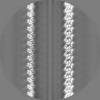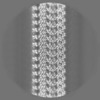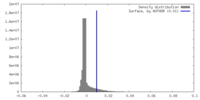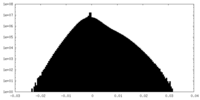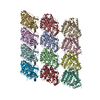[English] 日本語
 Yorodumi
Yorodumi- EMDB-50174: Undecorated 13pf mosaic 20%E254Q - 80% E254QN microtubule from re... -
+ Open data
Open data
- Basic information
Basic information
| Entry |  | ||||||||||||||||||
|---|---|---|---|---|---|---|---|---|---|---|---|---|---|---|---|---|---|---|---|
| Title | Undecorated 13pf mosaic 20%E254Q - 80% E254QN microtubule from recombinant human tubulin | ||||||||||||||||||
 Map data Map data | |||||||||||||||||||
 Sample Sample |
| ||||||||||||||||||
 Keywords Keywords | Microtubule Tubulin GTP cap Cell cycle / STRUCTURAL PROTEIN | ||||||||||||||||||
| Function / homology |  Function and homology information Function and homology informationnetrin receptor binding / Post-chaperonin tubulin folding pathway / dorsal root ganglion development / Cilium Assembly / cytoskeleton-dependent intracellular transport / Microtubule-dependent trafficking of connexons from Golgi to the plasma membrane / Carboxyterminal post-translational modifications of tubulin / Intraflagellar transport / Sealing of the nuclear envelope (NE) by ESCRT-III / Formation of tubulin folding intermediates by CCT/TriC ...netrin receptor binding / Post-chaperonin tubulin folding pathway / dorsal root ganglion development / Cilium Assembly / cytoskeleton-dependent intracellular transport / Microtubule-dependent trafficking of connexons from Golgi to the plasma membrane / Carboxyterminal post-translational modifications of tubulin / Intraflagellar transport / Sealing of the nuclear envelope (NE) by ESCRT-III / Formation of tubulin folding intermediates by CCT/TriC / Gap junction assembly / Prefoldin mediated transfer of substrate to CCT/TriC / Kinesins / COPI-independent Golgi-to-ER retrograde traffic / Assembly and cell surface presentation of NMDA receptors / COPI-dependent Golgi-to-ER retrograde traffic / Recycling pathway of L1 / RHOH GTPase cycle / RHO GTPases activate IQGAPs / microtubule-based process / Hedgehog 'off' state / COPI-mediated anterograde transport / Activation of AMPK downstream of NMDARs / intercellular bridge / cytoplasmic microtubule / Mitotic Prometaphase / EML4 and NUDC in mitotic spindle formation / peptide binding / MHC class II antigen presentation / cellular response to interleukin-4 / Recruitment of NuMA to mitotic centrosomes / axon guidance / HSP90 chaperone cycle for steroid hormone receptors (SHR) in the presence of ligand / Resolution of Sister Chromatid Cohesion / cell periphery / Translocation of SLC2A4 (GLUT4) to the plasma membrane / filopodium / RHO GTPases Activate Formins / PKR-mediated signaling / structural constituent of cytoskeleton / microtubule cytoskeleton organization / HCMV Early Events / Aggrephagy / The role of GTSE1 in G2/M progression after G2 checkpoint / mitotic spindle / Separation of Sister Chromatids / mitotic cell cycle / lamellipodium / double-stranded RNA binding / microtubule cytoskeleton / growth cone / Hydrolases; Acting on acid anhydrides; Acting on GTP to facilitate cellular and subcellular movement / microtubule / cilium / axon / cell division / neuronal cell body / GTPase activity / dendrite / ubiquitin protein ligase binding / GTP binding / structural molecule activity / extracellular exosome / metal ion binding / nucleus / cytoplasm Similarity search - Function | ||||||||||||||||||
| Biological species |  Homo sapiens (human) Homo sapiens (human) | ||||||||||||||||||
| Method | helical reconstruction / cryo EM / Resolution: 4.3 Å | ||||||||||||||||||
 Authors Authors | Estevez-Gallego J / Blum TB / Steinmetz MO / Surrey T | ||||||||||||||||||
| Funding support |  Spain, Spain,  Switzerland, European Union, 5 items Switzerland, European Union, 5 items
| ||||||||||||||||||
 Citation Citation |  Journal: Nat Commun / Year: 2025 Journal: Nat Commun / Year: 2025Title: Hydrolysis-deficient mosaic microtubules as faithful mimics of the GTP cap. Authors: Juan Estévez-Gallego / Thorsten B Blum / Felix Ruhnow / María Gili / Silvia Speroni / Raquel García-Castellanos / Michel O Steinmetz / Thomas Surrey /   Abstract: A critical feature of microtubules is their GTP cap, a stabilizing GTP-tubulin rich region at growing microtubule ends. Microtubules polymerized in the presence of GTP analogs or from GTP hydrolysis- ...A critical feature of microtubules is their GTP cap, a stabilizing GTP-tubulin rich region at growing microtubule ends. Microtubules polymerized in the presence of GTP analogs or from GTP hydrolysis-deficient tubulin mutants have been used as GTP-cap mimics for structural and biochemical studies. However, these analogs and mutants generate microtubules with diverse biochemical properties and lattice structures, leaving it unclear what is the most faithful GTP mimic and hence the structure of the GTP cap. Here, we generate a hydrolysis-deficient human tubulin mutant, αE254Q, with the smallest possible modification. We show that αE254Q-microtubules are stable, but still exhibit mild mutation-induced growth abnormalities. However, mixing two GTP hydrolysis-deficient tubulin mutants, αE254Q and αE254N, at an optimized ratio eliminates growth and lattice abnormalities, indicating that these 'mosaic microtubules' are faithful GTP cap mimics. Their cryo-electron microscopy structure reveals that longitudinal lattice expansion, but not protofilament twist, is the primary structural feature distinguishing the GTP-tubulin containing cap from the GDP-tubulin containing microtubule shaft. However, alterations in protofilament twist may be transiently needed to allow lattice compaction and GTP hydrolysis. Together, our results provide insights into the structural origin of GTP cap stability, the pathway of GTP hydrolysis and hence microtubule dynamic instability. | ||||||||||||||||||
| History |
|
- Structure visualization
Structure visualization
| Supplemental images |
|---|
- Downloads & links
Downloads & links
-EMDB archive
| Map data |  emd_50174.map.gz emd_50174.map.gz | 448.6 MB |  EMDB map data format EMDB map data format | |
|---|---|---|---|---|
| Header (meta data) |  emd-50174-v30.xml emd-50174-v30.xml emd-50174.xml emd-50174.xml | 19.4 KB 19.4 KB | Display Display |  EMDB header EMDB header |
| Images |  emd_50174.png emd_50174.png | 64.9 KB | ||
| Filedesc metadata |  emd-50174.cif.gz emd-50174.cif.gz | 6.9 KB | ||
| Others |  emd_50174_half_map_1.map.gz emd_50174_half_map_1.map.gz emd_50174_half_map_2.map.gz emd_50174_half_map_2.map.gz | 669.8 MB 669.8 MB | ||
| Archive directory |  http://ftp.pdbj.org/pub/emdb/structures/EMD-50174 http://ftp.pdbj.org/pub/emdb/structures/EMD-50174 ftp://ftp.pdbj.org/pub/emdb/structures/EMD-50174 ftp://ftp.pdbj.org/pub/emdb/structures/EMD-50174 | HTTPS FTP |
-Validation report
| Summary document |  emd_50174_validation.pdf.gz emd_50174_validation.pdf.gz | 1 MB | Display |  EMDB validaton report EMDB validaton report |
|---|---|---|---|---|
| Full document |  emd_50174_full_validation.pdf.gz emd_50174_full_validation.pdf.gz | 1 MB | Display | |
| Data in XML |  emd_50174_validation.xml.gz emd_50174_validation.xml.gz | 21 KB | Display | |
| Data in CIF |  emd_50174_validation.cif.gz emd_50174_validation.cif.gz | 25.1 KB | Display | |
| Arichive directory |  https://ftp.pdbj.org/pub/emdb/validation_reports/EMD-50174 https://ftp.pdbj.org/pub/emdb/validation_reports/EMD-50174 ftp://ftp.pdbj.org/pub/emdb/validation_reports/EMD-50174 ftp://ftp.pdbj.org/pub/emdb/validation_reports/EMD-50174 | HTTPS FTP |
-Related structure data
| Related structure data | 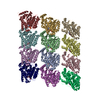 9f3hMC 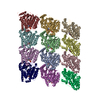 9f3bC 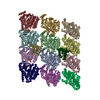 9f3rC  9f3sC M: atomic model generated by this map C: citing same article ( |
|---|---|
| Similar structure data | Similarity search - Function & homology  F&H Search F&H Search |
- Links
Links
| EMDB pages |  EMDB (EBI/PDBe) / EMDB (EBI/PDBe) /  EMDataResource EMDataResource |
|---|---|
| Related items in Molecule of the Month |
- Map
Map
| File |  Download / File: emd_50174.map.gz / Format: CCP4 / Size: 824 MB / Type: IMAGE STORED AS FLOATING POINT NUMBER (4 BYTES) Download / File: emd_50174.map.gz / Format: CCP4 / Size: 824 MB / Type: IMAGE STORED AS FLOATING POINT NUMBER (4 BYTES) | ||||||||||||||||||||||||||||||||||||
|---|---|---|---|---|---|---|---|---|---|---|---|---|---|---|---|---|---|---|---|---|---|---|---|---|---|---|---|---|---|---|---|---|---|---|---|---|---|
| Projections & slices | Image control
Images are generated by Spider. | ||||||||||||||||||||||||||||||||||||
| Voxel size | X=Y=Z: 0.955 Å | ||||||||||||||||||||||||||||||||||||
| Density |
| ||||||||||||||||||||||||||||||||||||
| Symmetry | Space group: 1 | ||||||||||||||||||||||||||||||||||||
| Details | EMDB XML:
|
-Supplemental data
-Half map: #2
| File | emd_50174_half_map_1.map | ||||||||||||
|---|---|---|---|---|---|---|---|---|---|---|---|---|---|
| Projections & Slices |
| ||||||||||||
| Density Histograms |
-Half map: #1
| File | emd_50174_half_map_2.map | ||||||||||||
|---|---|---|---|---|---|---|---|---|---|---|---|---|---|
| Projections & Slices |
| ||||||||||||
| Density Histograms |
- Sample components
Sample components
-Entire : Undecorated 13pf E254Q microtubule from recombinant human tubulin
| Entire | Name: Undecorated 13pf E254Q microtubule from recombinant human tubulin |
|---|---|
| Components |
|
-Supramolecule #1: Undecorated 13pf E254Q microtubule from recombinant human tubulin
| Supramolecule | Name: Undecorated 13pf E254Q microtubule from recombinant human tubulin type: organelle_or_cellular_component / ID: 1 / Parent: 0 / Macromolecule list: #1-#2 |
|---|---|
| Source (natural) | Organism:  Homo sapiens (human) Homo sapiens (human) |
-Macromolecule #1: Detyrosinated tubulin alpha-1B chain
| Macromolecule | Name: Detyrosinated tubulin alpha-1B chain / type: protein_or_peptide / ID: 1 / Number of copies: 6 / Enantiomer: LEVO |
|---|---|
| Source (natural) | Organism:  Homo sapiens (human) Homo sapiens (human) |
| Molecular weight | Theoretical: 50.718211 KDa |
| Recombinant expression | Organism:  Trichoplusia ni (cabbage looper) Trichoplusia ni (cabbage looper) |
| Sequence | String: MRECISIHVG QAGVQIGNAC WELYCLEHGI QPDGQMPSDK TIHHHHHHGG GHHHFNTFDS FNTFFSETGA GKHVPRAVFV DLEPTVIDE VRTGTYRQLF HPEQLITGKE DAANNYARGH YTIGKEIIDL VLDRIRKLAD QCTGLQGFLV FHSFGGGTGS G FTSLLMER ...String: MRECISIHVG QAGVQIGNAC WELYCLEHGI QPDGQMPSDK TIHHHHHHGG GHHHFNTFDS FNTFFSETGA GKHVPRAVFV DLEPTVIDE VRTGTYRQLF HPEQLITGKE DAANNYARGH YTIGKEIIDL VLDRIRKLAD QCTGLQGFLV FHSFGGGTGS G FTSLLMER LSVDYGKKSK LEFSIYPAPQ VSTAVVEPYN SILTTHTTLE HSDCAFMVDN EAIYDICRRN LDIERPTYTN LN RLISQIV SSITASLRFD GALNVDLTNF QTNLVPYPRI HFPLATYAPV ISAEKAYHEQ LSVAEITNAC FEPANQMVKC DPR HGKYMA CCLLYRGDVV PKDVNAAIAT IKTKRSIQFV DWCPTGFKVG INYQPPTVVP GGDLAKVQRA VCMLSNTTAI AEAW ARLDH KFDLMYAKRA FVHWYVGEGM EEGEFSEARE DMAALEKDYE EVGVDSVE UniProtKB: Tubulin alpha-1B chain |
-Macromolecule #2: Tubulin beta-3 chain
| Macromolecule | Name: Tubulin beta-3 chain / type: protein_or_peptide / ID: 2 / Number of copies: 6 / Enantiomer: LEVO |
|---|---|
| Source (natural) | Organism:  Homo sapiens (human) Homo sapiens (human) |
| Molecular weight | Theoretical: 51.276367 KDa |
| Recombinant expression | Organism:  Trichoplusia ni (cabbage looper) Trichoplusia ni (cabbage looper) |
| Sequence | String: MREIVHIQAG QCGNQIGAKF WEVISDEHGI DPSGNYVGDS DLQLERISVY YNEASSHKYV PRAILVDLEP GTMDSVRSGA FGHLFRPDN FIFGQSGAGN NWAKGHYTEG AELVDSVLDV VRKECENCDC LQGFQLTHSL GGGTGSGMGT LLISKVREEY P DRIMNTFS ...String: MREIVHIQAG QCGNQIGAKF WEVISDEHGI DPSGNYVGDS DLQLERISVY YNEASSHKYV PRAILVDLEP GTMDSVRSGA FGHLFRPDN FIFGQSGAGN NWAKGHYTEG AELVDSVLDV VRKECENCDC LQGFQLTHSL GGGTGSGMGT LLISKVREEY P DRIMNTFS VVPSPKVSDT VVEPYNATLS IHQLVENTDE TYCIDNEALY DICFRTLKLA TPTYGDLNHL VSATMSGVTT SL RFPGQLN ADLRKLAVNM VPFPRLHFFM PGFAPLTARG SQQYRALTVP ELTQQMFDAK NMMAACDPRH GRYLTVATVF RGR MSMKEV DEQMLAIQSK NSSYFVEWIP NNVKVAVCDI PPRGLKMSST FIGNSTAIQE LFKRISEQFT AMFRRKAFLH WYTG EGMDE MEFTEAESNM NDLVSEYQQY QDATAEEEGE MYEDDEEESE AQGPKENLYF Q UniProtKB: Tubulin beta-3 chain |
-Macromolecule #3: GUANOSINE-5'-TRIPHOSPHATE
| Macromolecule | Name: GUANOSINE-5'-TRIPHOSPHATE / type: ligand / ID: 3 / Number of copies: 12 / Formula: GTP |
|---|---|
| Molecular weight | Theoretical: 523.18 Da |
| Chemical component information | 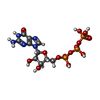 ChemComp-GTP: |
-Macromolecule #4: MAGNESIUM ION
| Macromolecule | Name: MAGNESIUM ION / type: ligand / ID: 4 / Number of copies: 12 / Formula: MG |
|---|---|
| Molecular weight | Theoretical: 24.305 Da |
-Experimental details
-Structure determination
| Method | cryo EM |
|---|---|
 Processing Processing | helical reconstruction |
| Aggregation state | helical array |
- Sample preparation
Sample preparation
| Concentration | 20 mg/mL |
|---|---|
| Buffer | pH: 6.8 |
| Grid | Model: C-flat-2/2 / Support film - Material: CARBON / Pretreatment - Type: GLOW DISCHARGE / Pretreatment - Time: 60 sec. |
| Vitrification | Cryogen name: ETHANE / Chamber humidity: 100 % / Chamber temperature: 310 K / Instrument: FEI VITROBOT MARK IV |
- Electron microscopy
Electron microscopy
| Microscope | TFS GLACIOS |
|---|---|
| Image recording | Film or detector model: FEI FALCON IV (4k x 4k) / Number grids imaged: 1 / Number real images: 3028 / Average electron dose: 7.25 e/Å2 |
| Electron beam | Acceleration voltage: 200 kV / Electron source:  FIELD EMISSION GUN FIELD EMISSION GUN |
| Electron optics | Illumination mode: FLOOD BEAM / Imaging mode: BRIGHT FIELD / Nominal defocus max: 2.5 µm / Nominal defocus min: 1.0 µm |
- Image processing
Image processing
| Final reconstruction | Number classes used: 1 Applied symmetry - Helical parameters - Δz: 9.59709 Å Applied symmetry - Helical parameters - Δ&Phi: -27.6692 ° Applied symmetry - Helical parameters - Axial symmetry: C13 (13 fold cyclic) Resolution.type: BY AUTHOR / Resolution: 4.3 Å / Resolution method: FSC 0.143 CUT-OFF / Software - Name: PHENIX (ver. 1.21) / Number images used: 30691 |
|---|---|
| Segment selection | Number selected: 44726 / Software - Name: RELION (ver. 3.1.2) |
| Startup model | Type of model: NONE |
| Final angle assignment | Type: PROJECTION MATCHING |
 Movie
Movie Controller
Controller










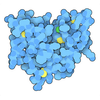

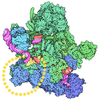

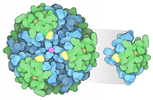






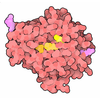


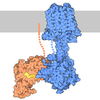
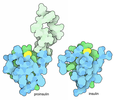
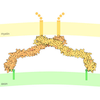
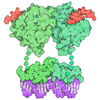






 Z (Sec.)
Z (Sec.) Y (Row.)
Y (Row.) X (Col.)
X (Col.)













